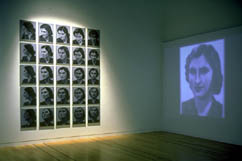
|
| Technical Details: 1 video
projector, 1 BVU player/ laser disc, 1 block of 25 paintings |
|
Old, anonymous, black-and-white photos often have a strange appeal to us: the lost image of reality, the solidified past that you see, represents unfamiliar people or places that no longer exist, which have gone. Nothing is more secretive or elusive that the lapse of time and the disappearance of people and things into time. Sometimes, in photos, faded images, Time almost becomes tangible, readable, but as frozen moments from the past, there is also a great deal left over to guess about, and the bygone reality remains hidden in the images. These are pictures which owe as much of their appeal to what they do not show as to what they do.
This is even more true of the photo portrait. A face is isolated from any other trace of 'reality'. This exposed face is virtually the only thing that gives us a possible clue: from the features, the expression, the clothes, and the hairstyle, you can try to discover who this is and what sort of world and life are concealed. It could stir your imagination, but in the end the face remains a mask which rejects your glance and barely gives anything away.
Bea de Visser based The Skipping Mind / A Film About Forgetting on an old photo
showing the portrait of an unknown woman, which she found in a second-hand book
at a jumble sale in Prague. For the first part of the installation, The Skipping
Mind, De Visser painted a series of 25 portraits modelled on this photo, in light
and dark grey tints. In each painting, the woman's head is in a different position,
from profile to full face, and her facial expression varies slightly as well.
At face value, this is a portrait from the forties, or perhaps the fifties, and the woman is about 35 years old. Her dark hair is parted on one side, waved into the nape of her neck, and the lapels of her dress or jacket are visible. In some of the portraits, there is the whisper of a smile on her face, whereas in others, she is sitting staring fixedly ahead.
In A Film About Forgetting, De Visser digitalized this series of portraits on the computer, and made them move with the help of 'morphing' software. The resulting video projection shows a more or less smooth-flowing range of images, in which the first portrait laps over into the second, and so on. The minimal movements remain somewhat jerky, as if the woman cannot really come alive and never gets beyond the beginning. The empty spaces between the portraits cannot really be filled in.
The Skipping Mind - A Film About Forgetting is an attempt to reconstruct, or even reanimate, a reality from the past, but De Visser was very much aware of the impossibility of such an attempt. This is an experiment against better judgement, which ventures onto the borderline between fiction and reality, between virtuality and reality. Despite 25 portraits and a film, the woman remains an enigma, the great absentee. Nor are we shown the original photo, so that another essential referent is lacking. We are merely presented with reproductions, but of what? The woman portrayed offers no solution, but your imagination has been activated.
Jorinde Seijdel
|
|
